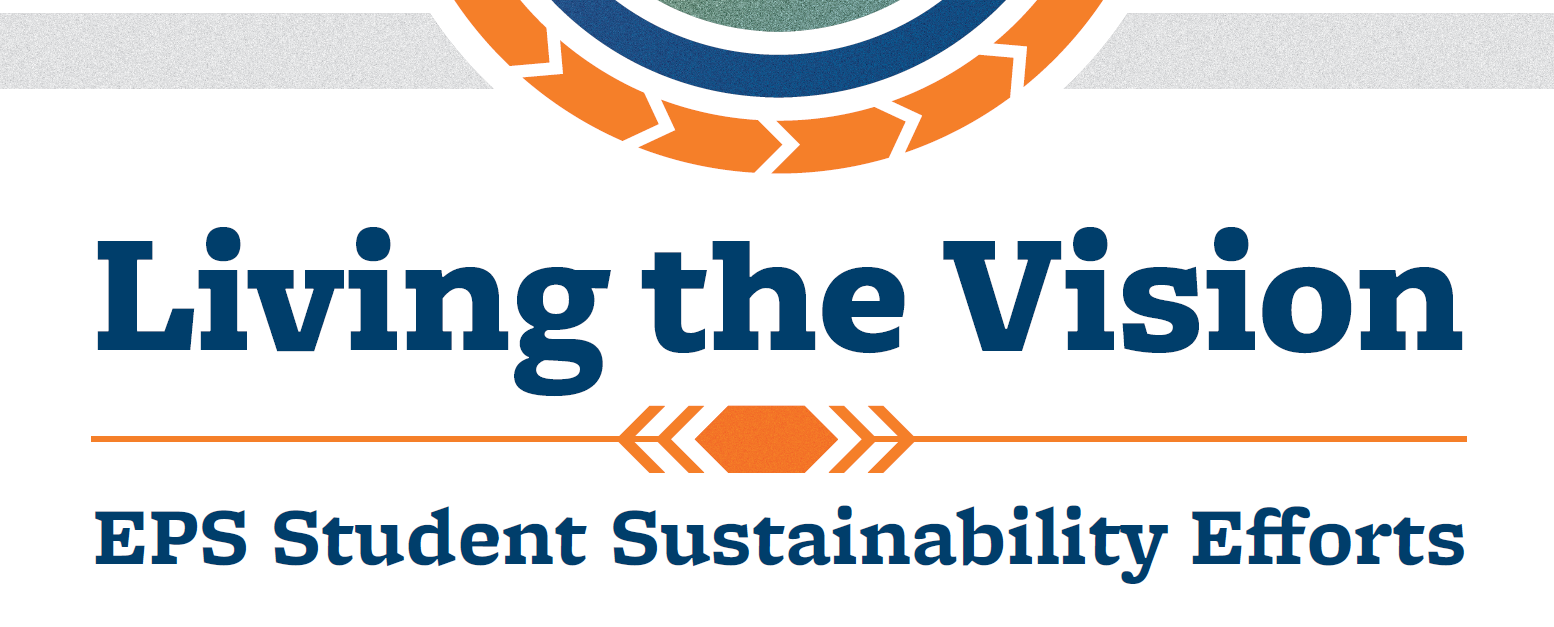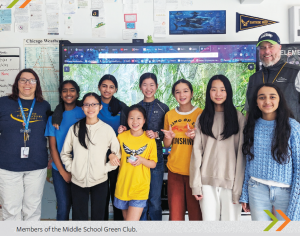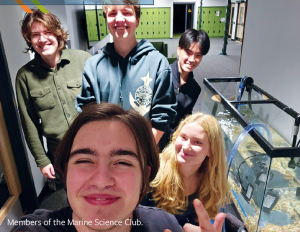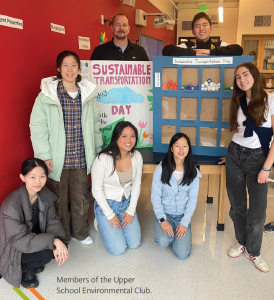
By Dr. Krissy Russell, Science Faculty
 The Earth is facing unprecedented challenges due to human manipulation of the environment, including biodiversity loss, deforestation, ocean acidification, plastic pollution, and global warming, among others. Eastside Prep is committed to addressing the sustainability of our institution through our most recent strategic priorities, and EPS Head of School Sam Uzwack reports that our sustainability will be examined in years two and three of the Strategic Plan. Part of that examination will most certainly include the campus sustainability efforts of our own students, which are currently flourishing. Members of the Middle School Green Club, Upper School Environmental Club, and the newly formed Upper School Marine Science Club are literally living the EPS vision as they innovate wisely (not to mention thinking critically, acting responsibly, and leading compassionately) to create a better world.
The Earth is facing unprecedented challenges due to human manipulation of the environment, including biodiversity loss, deforestation, ocean acidification, plastic pollution, and global warming, among others. Eastside Prep is committed to addressing the sustainability of our institution through our most recent strategic priorities, and EPS Head of School Sam Uzwack reports that our sustainability will be examined in years two and three of the Strategic Plan. Part of that examination will most certainly include the campus sustainability efforts of our own students, which are currently flourishing. Members of the Middle School Green Club, Upper School Environmental Club, and the newly formed Upper School Marine Science Club are literally living the EPS vision as they innovate wisely (not to mention thinking critically, acting responsibly, and leading compassionately) to create a better world.
Middle School Green Club
By Ivanka and Vera (both Class of 2029)
In the fall trimester, Green Club implemented the Ecobrick table on the Middle School building’s first floor. An Ecobrick is a plastic bottle stuffed with clean, plastic waste. The trash inside is so compact that it feels like a brick, which makes it a more efficient solution than putting waste in landfills as it takes up less space. Students can put their clean, plastic waste in the designated bin so that members of the Green Club can stuff them in the unfinished Ecobricks. By the end of the year, the Ecobricks will be transferred via the GoBrick website and will be used in various structures.
Recently we’ve placed Ecobrick waste bins around the offices of Counselor Foote, Counselor Sanchez and Ms. Peeden. Students often walk out of these places with candy, so we decided to place the Ecobrick waste bins there, as candy wrappers are a very common filling for Ecobricks.
We hope to soon update the shadow boxes, which are boxes above the trash, compost, and recycling in the LPC. They display trash items to guide students where an item goes. However, the examples displayed in these shadow boxes have not been updated for years, so we hope to add new examples specific to what is now being sold in the LPC to reduce the confusion about correct waste disposal.
We have been trying to spread awareness about the environment through assemblies. We have talked about correct waste disposal, preventing food waste, and more. We have also incorporated Upper School guest speakers in our assembly. For example, William (’24), developed a recycling app that uses the power of AI to recycle properly.
If you scan a piece of waste with this app, it will tell you what type of waste it is and how to properly dispose of it. This is very crucial moving forward and can increase people’s awareness of how to recycle properly. We are very excited to have invited another guest speaker from Orca Network to an assembly held in March. In sixth-grade history, we researched an issue we were passionate about and interviewed organizations also studying the issue. Catherine’s (’29) topic was about the protection of orca whales and the person she interviewed was from an organization called Orca Network. After the interview process, they offered to come and do an assembly at our school. We think this would be an excellent experience for all Middle Schoolers to learn more about orca endangerment and protection, and we are very excited to make this happen.
Our experience of being part of Green Club has been truly sensational! We joined Green Club at the beginning of our sixthgrade year and have learned so much about how to care for the environment. We enjoy spreading awareness to our community about different ways to protect the environment through assemblies and day-to-day activities. Our club sponsors, Dr. K and Mr. Barrager, are extremely supportive and knowledgeable about the protection of the environment and always help us learn new things. We look forward to learning more methods about how to protect the environment and raising awareness about the environmental problems happening right now and what we can do about them.
Marine Science Club
By Dylan (’25), Julian (’24), and Liam (’25)
 Marine Science Club is one of the newest clubs on the EPS club scene, but we are already making waves. The club was founded just this summer, born out of a love for the sea, the creatures that live in it, and all the fascinating research that revolves around the great big blue. Sadly, the wonderful world beneath the waves is constantly under threat from various human influences; habitat loss, overfishing, and pollution are all major threats to our seas. Creatures that used to fill our oceans are now greatly reduced in number. In the Pacific Northwest, our claim to fame has long been the multitude of vibrant salmon such as Chinook, Coho, Pink, Steelhead, and Sockeye that populate our waterways. Unfortunately, the last century has seen their populations take a massive dive due to the damming of essential rivers and overfishing. Chinook salmon, one of our resident species, has suffered a 60% decline in the last forty years alone according to the U.S. Environmental Protection Agency. To help combat this tragic decline in one of the PNW’s most iconic and beloved animals, Marine Science Club partnered with Salmon in Schools, a program run by the City of Seattle to help schools in the Seattle area host salmon fry tanks. Eventually, the schools release the fry into the wild, helping Washington’s salmon populations. The program also fosters a spirit of environmental stewardship and provides hands-on learning experiences for students across King County.
Marine Science Club is one of the newest clubs on the EPS club scene, but we are already making waves. The club was founded just this summer, born out of a love for the sea, the creatures that live in it, and all the fascinating research that revolves around the great big blue. Sadly, the wonderful world beneath the waves is constantly under threat from various human influences; habitat loss, overfishing, and pollution are all major threats to our seas. Creatures that used to fill our oceans are now greatly reduced in number. In the Pacific Northwest, our claim to fame has long been the multitude of vibrant salmon such as Chinook, Coho, Pink, Steelhead, and Sockeye that populate our waterways. Unfortunately, the last century has seen their populations take a massive dive due to the damming of essential rivers and overfishing. Chinook salmon, one of our resident species, has suffered a 60% decline in the last forty years alone according to the U.S. Environmental Protection Agency. To help combat this tragic decline in one of the PNW’s most iconic and beloved animals, Marine Science Club partnered with Salmon in Schools, a program run by the City of Seattle to help schools in the Seattle area host salmon fry tanks. Eventually, the schools release the fry into the wild, helping Washington’s salmon populations. The program also fosters a spirit of environmental stewardship and provides hands-on learning experiences for students across King County.
 With a partner and plan in place, the real work began. Our first task was to identify a space to house the fry tank, and we planned to have the tank folded into the Middle School science curriculum. So, naturally, we began our search in the newly constructed Middle School building. Before long, we found the perfect spot and did measurements to inform how much space we had for the tank and all the other bits and bobs we required. Our next step was by far the most daunting and arduous, as we spent two weeks researching all there was to know about tanks, filters, pH monitors, thermometers, and chillers. We then made a list of all the items and their respective cost before ordering them. After returning from the break, a dedicated team of Club members spent hours building the tank, and eggs arrived on January 9. A special thank-you goes out to our club sponsor, Dr. Seeley, the rest of the EPS science faculty, and Mr. Uzwack for their willingness to work to help this dream come true and their generosity when it came to the budget. At the Marine Science Club, we hope to see this tank become a permanent fixture in the EPS community, a tool for teaching about the importance of protecting the environment and all that live in it.
With a partner and plan in place, the real work began. Our first task was to identify a space to house the fry tank, and we planned to have the tank folded into the Middle School science curriculum. So, naturally, we began our search in the newly constructed Middle School building. Before long, we found the perfect spot and did measurements to inform how much space we had for the tank and all the other bits and bobs we required. Our next step was by far the most daunting and arduous, as we spent two weeks researching all there was to know about tanks, filters, pH monitors, thermometers, and chillers. We then made a list of all the items and their respective cost before ordering them. After returning from the break, a dedicated team of Club members spent hours building the tank, and eggs arrived on January 9. A special thank-you goes out to our club sponsor, Dr. Seeley, the rest of the EPS science faculty, and Mr. Uzwack for their willingness to work to help this dream come true and their generosity when it came to the budget. At the Marine Science Club, we hope to see this tank become a permanent fixture in the EPS community, a tool for teaching about the importance of protecting the environment and all that live in it.
Upper School Environmental Club
By Elyse (’24), Erela (’26), Sophie (’25), Vehd (’26), Andrew (’26), and Xinyuan (’25)
 We believe it’s our school’s responsibility to use our technological advancements to honor and conserve the nature around us. In fall 2022, the new freshmen of the club had difficulty finding information about Eastside Prep’s environmental footprint, and thus, a new project was born. The Energy Efficiency Project aims to track and analyze EPS’s climate impact—from electricity, gas, and water usage to the emissions released by EPS buses and EBC trips. Analyzing our school’s existing resource data, we intend to propose future recommendations for minimizing our carbon footprint.
We believe it’s our school’s responsibility to use our technological advancements to honor and conserve the nature around us. In fall 2022, the new freshmen of the club had difficulty finding information about Eastside Prep’s environmental footprint, and thus, a new project was born. The Energy Efficiency Project aims to track and analyze EPS’s climate impact—from electricity, gas, and water usage to the emissions released by EPS buses and EBC trips. Analyzing our school’s existing resource data, we intend to propose future recommendations for minimizing our carbon footprint.
Around the same time the Energy Efficiency Project was created, the Environmental Club started working on a long-term project to restore Cochran Springs Creek. We hope to help native wildlife thrive, and perhaps eventually, be able to see salmon swim through it. There is currently a huge overgrowth of plants spanning several acres that will need to be removed to make space for the planting of native species, which will have to be timed according to their planting seasons. This sheer amount of labor will take multiple years, but one day seeing the thriving stream will make all the work worth it.
Another ongoing Environmental Club effort is Sustainable Impact Day (SID). Originally established as Sustainable Transportation Day, this recurring event on the first Wednesday of each month has now broadened its scope to promote all aspects of sustainability. The intent behind SID is to encourage EPS students and faculty to be mindful of their carbon footprint and to take sustainable actions in lieu of what they do on a regular basis. To incentivize our community to take part in this endeavor, a sustainability-themed prize is on the table for those with the most monthly submissions at the end of the year.
EBC Week is a cornerstone of the EPS experience. However, the carbon emissions from a round-trip flight to Asia are equivalent to those produced by the average person in an entire month. Our EBC Carbon Offsets Project aims to help reduce this impact. We use a formula to meticulously calculate the estimated carbon emissions resulting from the road and plane travels on each EBC trip. This enables us to recommend a donation amount that goes toward reforestation projects around the world to offset these emissions. Through these various efforts, the Environmental Club strives to help EPS make improvements and ultimately reach a net-zero impact.
Through these various efforts, the Environmental Club strives to help EPS make improvements and ultimately reach a net-zero impact.

